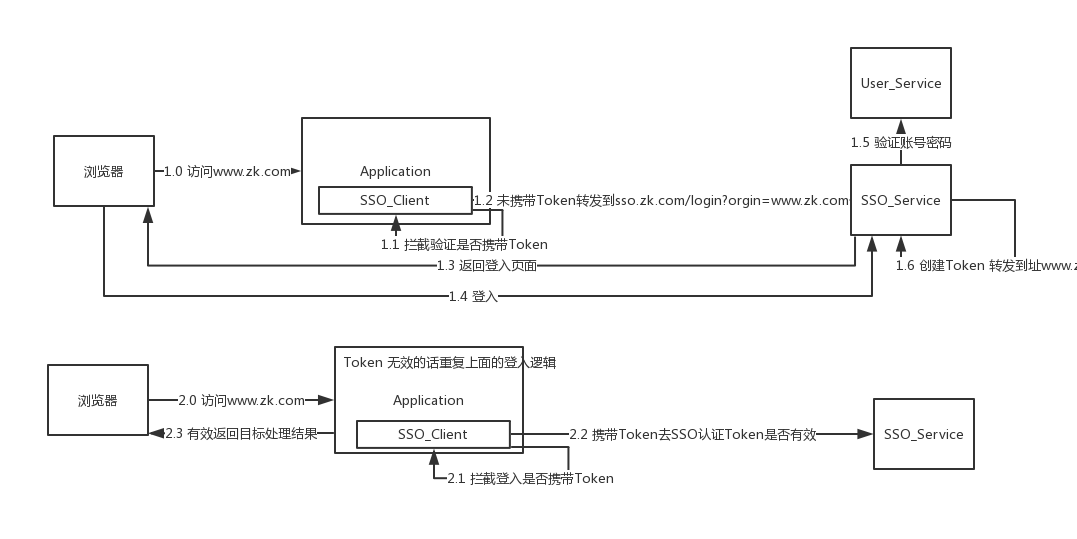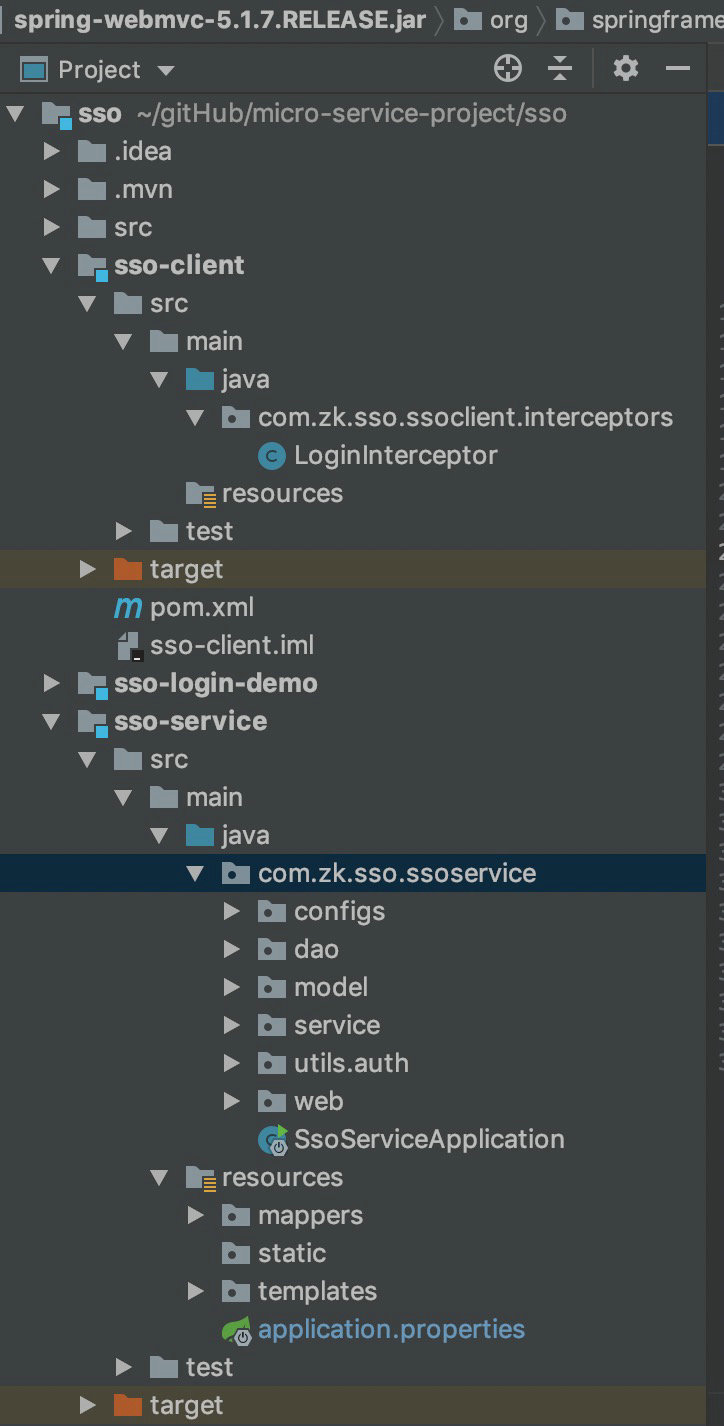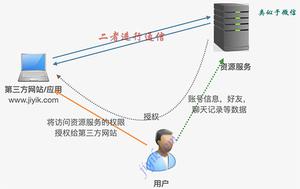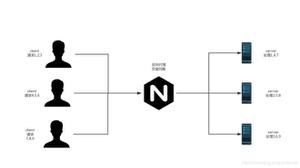SSO单点登入SpringBoot实现
Why 单点登入?
一次登入,到处畅行!
前面我们讲了水平扩容多机部署时Session一致性的解决方案!在我们公司日常开发中一般不止一个应用如:商品 / 订单 / 客户 这些模块都要有登入!我们是不是可以讲登入做成模块形式来统一管理呢??
 SSO大概流程模块划分图
SSO大概流程模块划分图
通过上图可知我们分为3大块
- SSO-Client
- SSO-Service
- User-Service
SSO-Client
主要做登入拦截,这个是做成Jar包的方式集成进目标应用。
- 拦截方式
- javax.servlet.Filter servlet 过滤器方式
- org.springframework.web.servlet.HandlerInterceptor Spring拦截器方式
SSO-Service
主要用于登入,身份认证!一些常用信息存储等。
User-Service
需要登入的话必然我们就需要用户信息相关操作的!其实是作为一个单独作为一个依赖服务的。
Why 同域和跨域?
这是浏览器为了安全的一种保护行为!**跨域资源调度限制**。你可以试着考虑下,你先登入www.taobao.com,然后再登入 www.baidu.com。 难道你要把淘宝域名下的cookie发送给百度的服务器吗? 但是我们正常的开发中可能一个公司内部有多个系统多个域名,我们需要打通的各个系统的登入。这时候我们就面临新的挑战了! **跨域**
同源策略:
协议 | 域名 | 端口 都要相同,不然就会产生跨域问题
| URL | 说明 | 是否跨域 |
|---|---|---|
| http://www.taobao.com/itemhttp://www.taobao.com/user | 相同协议,域名,端口 | 否 |
| http://www.taobao.com/item/app.jshttp://www.taobao.com/user/defult.js | 相同协议,域名,端口 不同资源 | 否 |
| http://www.zk.com:8080/http://www.zk.com:8083/ | 相同协议,域名 不同端口 | 是 |
| http://www.zk.com:8080/https://www.zk.com:8080/ | 相同域名,端口 不同协议 | 是 |
| http://127.0.0.1:8080/http://www.zk.com:8080/ | 如果该域名指向的就是该IP 也是跨域了 | 是 |
| http://www.zk.com:8080/http://user.zk.com:8080/ | 主域和子域 | 是 |
| http://www.baidu.com/http://www.taobao.com/ | 不同域名 | 是 |
跨域解决方案:
- JSONP: 这个方案只支持GET请求,遇到携带信息量较大的话会带来一些性能问题。暂时我没有详细研究,大家感兴趣可以自行研究。优点是支持比较老得浏览器!
- CORS: 全称 跨域资源共享 注意:这个需要浏览器和服务器同时支持。除了一些微软系列比较老得浏览器,现在市面谷歌,火狐,猎豹啊的都支持的。莫名打了广告哈哈😅。
- … 其他方案网上给出来的总共8种吧,应用我觉得主要就是以上两种。好滴,接下来我们来讲讲 CORS !
两种请求:
浏览器会将CORS请求分为:**简单请求**(simple request) 和 **非简单请求**(not-so-simple request)- 简单请求: 需要满足两大条件
- 请求方法:三种之一就好!
- HEAD
- GET
- POST
- 请求字段:不超出以下几种字段。
- Accpet : 代表发送端希望接收的数据类型(媒体类型资源)
- Accpet-Language:代表客户端希望接收的语言类型
- Content-Language:代表发送端的语言类型
- Last-Event-ID:
- Content-Type: 代表发送端的数据类型(媒体类型资源),只限三个值!
- application/x-www-form-urlencoded
- multipart/form-data
- text/plain
- 请求方法:三种之一就好!
- 非简单请求: 会在正式请求之前增加一个预检查请求(options 类型)注意需要配置文件web.xml开启这个请求类型!收到请求后才会执行真正的操作。
上硬菜 代码: springBoot项目
/* web配置*/
publicclassimplementsWebMvcConfigurer{
publicvoidaddCorsMappings(CorsRegistry registry){
registry.addMapping("/**")
//授权的访问源
.allowedOrigins("*")
//允许的请求动词
.allowedMethods("POST, GET, OPTIONS, DELETE")
//预检授权的有效期,单位:秒
.maxAge(3600)
//额外允许访问的响应头
.allowedHeaders("x-requested-with")
//是否允许携带
.allowCredentials(true);
}
}
估计你们肯定会想就这么简单吗? 我想说是的。还是扩展性更强的写法。
配置详解:
- Access-Control-Allow-Origin 必填: 必填 授权访问资源 * 表示所有资源可以访问。你也可以填写一个具体的域名
- Access-Control-Allow-Methods 必填: 允许跨域的方法 如POST, GET …
- Access-Control-Max-Age: 预授权(非简单请求的预检查)的有效期,有效期内不用在发送一条检查请求。
- Access-Control-Expose-Headers: 额外允许访问的响应头 CORS请求时,XMLHttpRequest对象的getResponseHeader()方法只能拿到6个基本字段:Cache-Control、Content-Language、Content-Type、Expires、Last-Modified、Pragma。如果想拿到其他字段,就必须在Access-Control-Expose-Headers里面指定。
- Access-Control-Allow-Credentials: 是否允许携带cookie ,默认不携带,我们在Cookie存储Token肯定是需要的!
我肯定写的比较分散 有点像矮大紧想到哪里,就讲到哪里呢! 大家不要在意这些细节,我收回来。
代码实现SSO!
 sso目录结构
sso目录结构
SSO-Client: 代码
- 新建Spring-Boot 工程!名字sso, 创建子模块sso-client
- pom.xml
<dependencies>
<groupId>org.springframework.boot</groupId>
<artifactId>spring-boot-starter-web</artifactId>
</dependency>
<!-- http客户端 -->
<dependency>
<groupId>org.apache.httpcomponents</groupId>
<artifactId>httpclient</artifactId>
<version>4.5.9</version>
</dependency>
</dependencies>
- 新建拦截器 我这里选用的Interceptor方式
* 登入拦截*
* @author zhoukun
*/
publicclassLoginInterceptorimplementsHandlerInterceptor{
privatestaticfinal String OK = "ok";
publicbooleanpreHandle(HttpServletRequest request, HttpServletResponse response, Object handler)throws Exception {
String token = request.getHeader("token");
if (StringUtils.isEmpty(token)) {
token = request.getParameter("token");
}
if (StringUtils.isEmpty(token)) {
Cookie[] cookies = request.getCookies();
if (cookies != null && cookies.length > 0) {
for (Cookie cookie : cookies) {
if (cookie.getName().equals("token")) {
token = cookie.getValue();
}
}
}
}
String originUrl = request.getRequestURL().toString();
if (StringUtils.isEmpty(token)) {
response.sendRedirect("http://127.0.0.1:2080?originUrl=" + originUrl);
returnfalse;
}
// if (!StringUtils.isEmpty(token)) {
// Cookie cookie = new Cookie("token", token);
// cookie.setDomain("zk.com");
// response.addCookie(cookie);
// }
Map<String, String> map = new HashMap<>();
map.put("token", token);
String result = httpClientGet(map);
if (OK.equalsIgnoreCase(result)) {
returntrue;
} else {
response.sendRedirect("http://127.0.0.1:2080?originUrl=" + originUrl);
returnfalse;
}
}
publicstatic String httpClientGet(Map<String, String> map)throws URISyntaxException, IOException {
CloseableHttpClient httpClient = HttpClientBuilder.create().build();
List<NameValuePair> params = new ArrayList<>();
map.forEach((k, v) ->
params.add(new BasicNameValuePair(k, v))
);
URI uri = new URIBuilder().setScheme("http").setHost("localhost")
.setPort(2080).setPath("/auth/token")
.setParameters(params).build();
HttpGet get = new HttpGet(uri);
CloseableHttpResponse response = httpClient.execute(get);
HttpEntity responseEntity = response.getEntity();
System.out.println("响应状态为:" + response.getStatusLine());
String result = EntityUtils.toString(responseEntity);
httpClient.close();
response.close();
return result;
}
}
SSO-Service 代码:
- sso 下面新建子工程 sso-servie
- 编写jwt 工具类上篇文章已经介绍过了这里就不多讲
- pom.xml
<dependency><groupId>org.springframework.boot</groupId>
<artifactId>spring-boot-starter-web</artifactId>
</dependency>
4.编写 登入类
* 登入页面*/
publicclassLoginController{
private UserService userService;
("/")
public String form(HttpServletRequest request, HttpServletResponse response){
String originUrl = request.getParameter("originUrl");
request.getSession().setAttribute("originUrl", originUrl);
return"login";
}
("/login")
public String login(HttpServletRequest request, HttpServletResponse response,
@RequestParam("username") String username, @RequestParam("password") String password) throws IOException {
if (StringUtils.isEmpty(username)) {
return"username not null";
}
if (StringUtils.isEmpty(password)) {
return"password not null";
}
UserDo userDo = userService.verifyUser(username, password);
if (userDo == null) {
return"密码或者账号错误!";
}
Map<String, String> claims = new HashMap<>();
claims.put("id", String.valueOf(userDo.getId()));
claims.put("username", userDo.getUserName());
LocalDateTime exprieLocalDateTime = LocalDateTime.now().plusMinutes(10L);
ZonedDateTime zonedDateTime = exprieLocalDateTime.atZone(ZoneId.systemDefault());
String token = JwtUtil.generateToken(claims, Date.from(zonedDateTime.toInstant()));
Cookie cookie = new Cookie("token", token);
response.addCookie(cookie);
response.setHeader("token", token);
String originUrl = (String) request.getSession().getAttribute("originUrl");
response.sendRedirect(originUrl + "?token=" + token);
return token;
}
}
- 认证类
* 认证Token*/
("auth")
publicclassAuthTokenController{
publicstaticfinal String OK = "OK";
publicstaticfinal String FAIL = "FAIL";
("token")
public String authToken(HttpServletRequest request, HttpServletResponse response){
String token = request.getParameter("token");
try {
Map<String, String> map = JwtUtil.verifyToken(token);
return OK;
} catch (Exception e) {
e.printStackTrace();
return FAIL;
}
}
}
小叙:
这个是一个比较简单的实现很多地方都不不是特别验证,比如跨域携带, jwtToken实时刷新等等问题,都没有解决 这个这是打个样,我们什么都是从简单到深入,踩很多坑和雷的。接下的文章会更加深入探讨这些问题的。
以上是 SSO单点登入SpringBoot实现 的全部内容, 来源链接: utcz.com/a/11446.html





